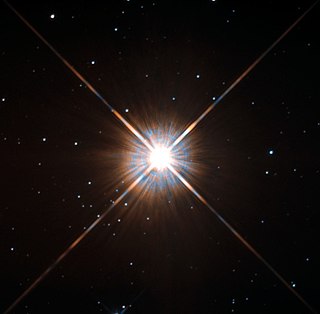
Proxima Centauri is the nearest star to Earth after the Sun, located 4.25 light-years away in the southern constellation of Centaurus. This object was discovered in 1915 by Robert Innes. It is a small, low-mass star, too faint to be seen with the naked eye, with an apparent magnitude of 11.13. Its Latin name means the 'nearest [star] of Centaurus'. Proxima Centauri is a member of the Alpha Centauri star system, being identified as component Alpha Centauri C, and is 2.18° to the southwest of the Alpha Centauri AB pair. It is currently 12,950 AU (0.2 ly) from AB, which it orbits with a period of about 550,000 years.

Ross 128 is a red dwarf star in the equatorial zodiac constellation of Virgo, near β Virginis. The apparent magnitude of Ross 128 is 11.13, which is too faint to be seen with the unaided eye. Based upon parallax measurements, the distance of this star from Earth is 11.007 light-years, making it the twelfth closest stellar system to the Solar System. It was first cataloged in 1926 by American astronomer Frank Elmore Ross.
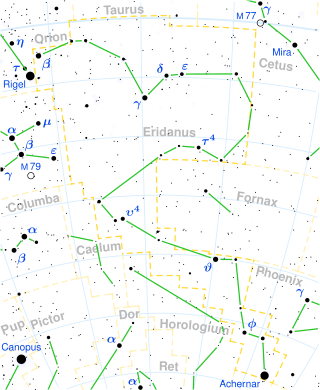
40 Eridani is a triple star system in the constellation of Eridanus, abbreviated 40 Eri. It has the Bayer designation Omicron2 Eridani, which is Latinized from ο2 Eridani and abbreviated Omicron2 Eri or ο2 Eri. Based on parallax measurements taken by the Gaia mission, it is about 16.3 light-years from the Sun.

Gliese 65, also known as Luyten 726-8, is a binary star system that is one of Earth's nearest neighbors, at 8.8 light-years from Earth in the constellation Cetus. The two component stars are both flare stars with the variable star designations BL Ceti and UV Ceti.
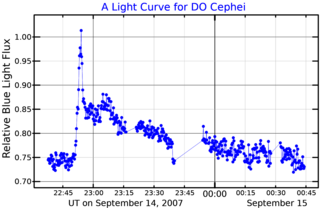
Krüger 60 is a binary star system located 13.1 light-years from the Sun. These red dwarf stars orbit each other every 44.6 years.

A flare star is a variable star that can undergo unpredictable dramatic increases in brightness for a few minutes. It is believed that the flares on flare stars are analogous to solar flares in that they are due to the magnetic energy stored in the stars' atmospheres. The brightness increase is across the spectrum, from X-rays to radio waves. Flare activity among late-type stars was first reported by A. van Maanen in 1945, for WX Ursae Majoris and YZ Canis Minoris. However, the best-known flare star is UV Ceti, first observed to flare in 1948. Today similar flare stars are classified as UV Ceti type variable stars in variable star catalogs such as the General Catalogue of Variable Stars.
Struve 2398 is a binary star system in the northern constellation of Draco. Struve 2398 is star number 2398 in the Struve Double Star Catalog of Russian-German astronomer Friedrich Georg Wilhelm von Struve. The astronomer's surname, and hence the star identifier, is sometimes indicated by a Greek sigma, Σ; hence, this system can be listed with the identifier Σ 2398. Although the components are too faint to be viewed with the naked eye, this star system is among the closest to the Sun. Parallax measurements by the Gaia spacecraft give them an estimated distance of 11.5 light-years away.
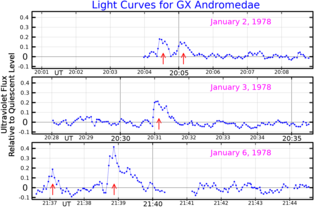
Groombridge 34 is a binary star system in the northern constellation of Andromeda. It was listed as entry number 34 in A Catalogue of Circumpolar Stars, published posthumously in 1838 by British astronomer Stephen Groombridge. Based upon parallax measurements taken by the Gaia spacecraft, the system is located about 11.6 light-years from the Sun. This positions the pair among the nearest stars to the Solar System.
DENIS J1048−3956 is an exceptionally small, dim ultra-cool red dwarf star 13.2 light-years from Earth in the southern constellation of Antlia, among the stars closest to Earth. This star is very dim with an apparent magnitude of about 17, and requires a telescope with a camera to be seen. It was discovered in 2000 by Xavier Delfosse and Thierry Forveille, with the assistance of nine other astronomers.

GJ 1245 is a double star with components G 208-44 and G 208-45, located 15.2 light-years away in the constellation Cygnus. G 208-44 is itself a closer double star made up of two red dwarfs, while G 208-45 is also a red dwarf. GJ 1245 is the 43rd closest stellar system to the Solar System. GJ 1245 A and B are active flare stars, and the pair are collectively designated V1581 Cygni.

Theta Persei is a star system 37 light years away from Earth, in the constellation Perseus. It is one of the closest naked-eye stars.
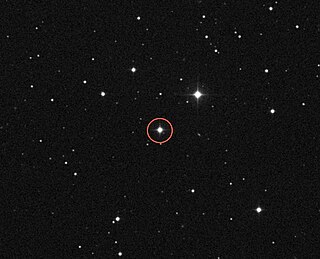
Gliese 445 is an M-type main sequence star in the northern part of the constellation Camelopardalis.

AT Microscopii is a binary star system located at a distance of 35 ly (11 pc) from the Sun in the constellation of Microscopium. Both members are flare stars, meaning they are red dwarf stars that undergo random eruptions that increase their brightness. This pair lies physically near the red dwarf star AU Microscopii, which may mean they form a wide triple star system.

HD 41742 and HD 41700 is a star system that lies approximately 88 light-years away in the constellation of Puppis. The system consists of two bright stars where the primary is orbited by two fainter stars, making it a quadruple with an unequal hierarchy.
HD 165185 is the Henry Draper Catalogue designation for a star in the southern zodiac constellation of Sagittarius. It has an apparent visual magnitude of 5.94, which indicates it is a sixth magnitude star that is faintly visible to the naked eye. Parallax measurements give an estimated distance of 55.8 light years from the Sun. It is drifting further away with a heliocentric radial velocity of +15.4 km/s.
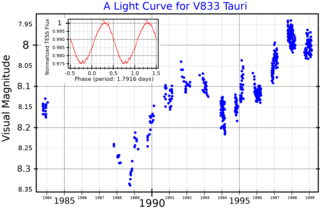
HD 283750, also known as V833 Tauri, is a K-type main-sequence star 57 light-years away from the Sun. The star is much younger than the Sun's at 1 billion years. HD 283750 is similar to the Sun in its concentration of heavy elements.
HR 4098, also known as HD 90508, is a binary star system in the northern constellation of Ursa Major at a distance of 75 light years. This object is barely visible to the naked eye as a dim, yellow star with an apparent visual magnitude of 6.45. It is approaching the Earth with a heliocentric radial velocity of 7.2±0.2 km/s.

V1005 Orionis is a young flare star in the equatorial constellation of Orion. It has the identifier GJ 182 in the Gliese–Jahreiß catalogue; V1005 Ori is its variable star designation. This star is too faint to be visible to the naked eye, having a mean apparent visual magnitude of 10.1. It is located at a distance of 79.6 light years from the Sun and is drifting further away with a radial velocity of 19.2 km/s. The star is a possible member of the IC 2391 supercluster.

BX Trianguli is a binary system made up of two red dwarfs, in the constellation Triangulum. Both stars eclipse each other and have an orbital period of four hours and 40 minutes. They are located at around 170 light-years from Earth based upon parallax measurements.















